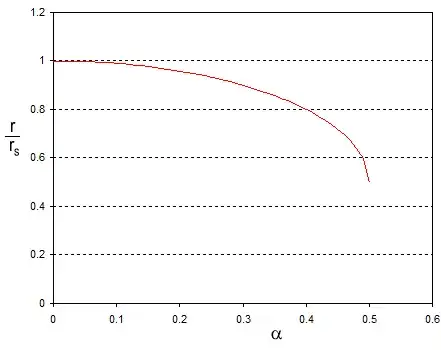The spacetime geometry around a rotating uncharged black hole is described by the Kerr metric. I'll give this below, and it will look terrifying, but bear with me because there's only one small bit of the equation we need to see why the horizon disappears. Anyhow, the Kerr metric is:
$$\begin{align}
ds^2 &= -(1 - \frac{r_s r}{\rho^2})dt^2 \\
&+ \frac{\rho^2}{\Delta}dr^2 \\
&+ \rho^2d\theta^2 \\
&+ (r^2 + \alpha^2 + \frac{r_s r\alpha^2}{\rho^2}\sin^2\theta)\sin^2\theta d\phi^2 \\
&+ \frac{2r_sr\alpha\sin^2\theta}{\rho^2}dt d\phi
\end{align}$$
Where:
$$\begin{align}
r_s &= 2M \\
\alpha &= \frac{J}{M} \\
\rho^2 &= r^2 + \alpha^2\cos^2\theta \\
\Delta &= r^2 - r_sr + \alpha^2
\end{align}$$
In the equation $J$ is the angular momentum of the black hole, $r$ is the distance from the centre of the black hole, $\theta$ is the latitude, $\phi$ is the longitude and $t$ is time. The parameter being calculated $ds$ is the total distance moved if you move by a distance $dr$ and angles $d\theta$ and $d\phi$ in a time $dt$.
Now, suppose we stay at some fixed angle relative to the black hole so $d\theta = d\phi = 0$, and we measure the distance along the radius to the centre of the black hole. We'll choose some fixed time $t$ for the measurement, so $dt = 0$. With all these restrictions the metric simplifies drastically to:
$$ ds^2 = \frac{\rho^2}{\Delta}dr^2 $$
and this is what we need to understand the behaviour of the horizon, because the event horizon radius is the value of $r$ for which the value of $ds^2$ goes to infinity. This happens when $\Delta = 0$, because then we get a division by zero. So to find the event horizon radius we just have to solve the equation:
$$ \Delta = r^2 - r_sr + \alpha^2 = 0 $$
and this is just a quadratic in $r$, like we all learned to solved at school. Using the quadratic formula the solution is (given by the larger root):
$$ r = \frac{r_s + \sqrt{r_s^2 - 4\alpha^2}}{2} \tag{1} $$
And the variation of the event horizon radius $r$ with $\alpha/r$ looks like:

Note that the line stops at $r/r_s = 0.5$ and $\alpha/r_s = 0.5$. The line stops here because beyond this point the equation (1) for $r$ has no real roots, and this means there is no event horizon. But remember that $\alpha$ is linked to the angular momentum $J$ by:
$$ \alpha = \frac{J}{M} $$
So for any value of the angular momentum $J > M$ there is no event horizon, and this is why the event horizon disappears when you spin the black hole too fast.
However there are good reasons to suppose that a black hole can never spin this fast, and the disappearance of the event horizon isn't real, but rather a sign that we've tried to apply the Kerr metric to a system that cannot physically exist. There is an article here (160KB PDF) analysing the physics, and the conclusions are that it is physically impossible to spin a black hole that fast.
